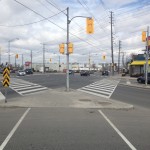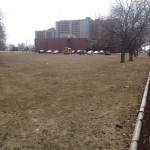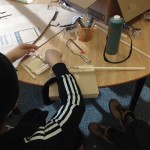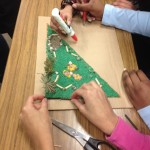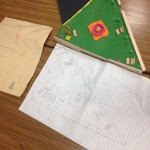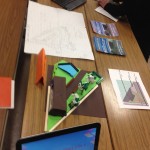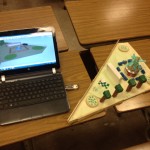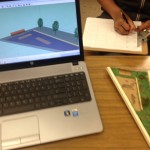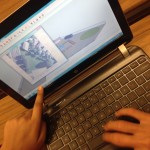The Grade 8 teaching staff focused on how to increase student achievement in the area of geometry through collaborative inquiry, cross-curricular tasks, and differentiated instruction via STEM teaching and learning. It was found that approximately 50 per cent of the current Grade 8 students faced challenges in the area of geometry based on their Grade 6 EQAO results. The school is listed as a high-needs school with a Learning Opportunities Index of 93. Funding provided release time for the professional learning cycle of time to plan, act, observe and reflect. Together, the team planned lessons incorporating three-part lessons, technology and the use of manipulatives. A timeline was decided upon and teaching staff recorded their observations and shared them during the release time (i.e., moderated marking and planning). The staff met to discuss the observations and adjust and/or implement strategies as necessary. In the final meeting, staff evaluated the process and discussed how to present findings to other networks and design a presentation.
Team Members
Jeanette Timbury
Toronto District School Board
Charlotte Ramsay
Toronto District School Board
Richard Baxter
Toronto District School Board
Simon Hall
Toronto District School Board
Cathrina Schoenfeld
Toronto District School Board
Professional Learning Goals
- increased content knowledge in the area of geometry for all students, including students with IEPs and behavioural challenges
- learned to integrate technology and manipulatives with geometry
- developed and shared three-part lessons that were implemented in classroom instruction during problem-solving activities
- learned assessment and evaluation strategies through the moderated marking of student work samples and use of Assessment for Learning template and ONAP
- built cross-curricular connections
- built real-life relevance for students
Activities and Resources
- 5 face-to-face collaborative inquiry sessions through the provision of release time to plan, act, observe and reflect
- a series of math lessons covering specific expectations leading to the three-day Geotricity culminating task
- TDSB, ministry and additional resources (ONAP, Nelson Mathematics 8, Geometer’s Sketchpad 5.0, Edugains, Ontario math curriculum document, TIPS4RM) to increase content knowledge in geometry, become familiar in use and application of manipulatives and the technology to teach geometry
- the team shared samples of student work and participated in moderated marking during release time
- on-going professional dialogue between the team, administration and Model Schools staff
Unexpected Challenges
- all activities contributed to our learning
- more planning time would have been beneficial
- more scaffolding/collaborative lessons prior to the workshop; we can now identify some tasks that would need more intensive teaching prior to the culminating task like scale drawing and diagonals
- more teaching time for students and teachers to explore Geometer’s Sketchpad 2.0 and Sketch-Up prior to the culminating task
Enhancing Student Learning and Development
- through implementation of the three-part lesson, the students increased their use of manipulatives
- enhanced student learning and development in the area of geometry
- provided skills that will be transferred to other strands (Number Sense and Numeration and Measurement) and, therefore, increased student engagement in mathematics
- increased confidence in mathematics and awareness of the interconnectedness of math strands and other curriculum areas
- experienced the engineering and design process by planning, designing and building a model for a specific land use in the school community (STEM) to make real-world connections
Sharing
- tweeted on TDSB
- shared with Learning Classroom Teachers in the MSIC Math Teacher Learning Network in cluster A1
- planning to share with Grade 7 teachers at the school during professional learning time
- planning to share with Toronto Urban Studies Centre teachers
Project Evaluation
- the project was successful as students were engaged and made real-life connections
- success criteria and rubrics were used
- student interviews, surveys and discussions showed a positive increase in the enjoyment of a math task
- increased teacher-content knowledge of geometry
- assessment as learning helped identify mathematical concepts that needed further development and these ideas can be added to the project for next time
- increased teacher understanding of student mathematical ability through moderated marking and the culminating task
- students were able to see their community in a different way and incorporate land use ideas and urban planning with math and science
- more lessons teaching specific concepts prior to the workshop was needed
- more release time for teachers to plan and evaluate
Resources Used
Curriculum Document
http://www.edu.gov.on.ca/eng/curriculum/elementary/math18curr.pdf
Ontario Numeracy Assessment Package 8 (ONAP)
Simmons et al, Ontario Numeracy Assessment Package (ONAP) Grade 8. Toronto, ON: Nelson Education Limited, 2010.
Math textbooks:
Ainslie et al. Mathematics 8: Making Connections. Toronto, ON: McGraw-Hill Ryerson, 2005.
Brown et al. Math Makes Sense 8. Toronto, ON: Pearson Education Canada Inc., 2006.
Resources Created
These resources will open in your browser in a new tab, or be downloaded to your computer.


